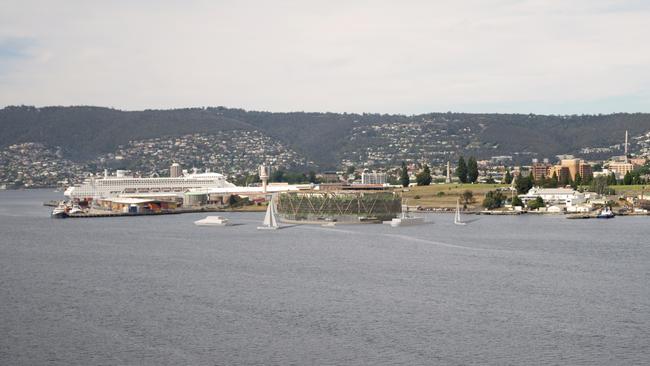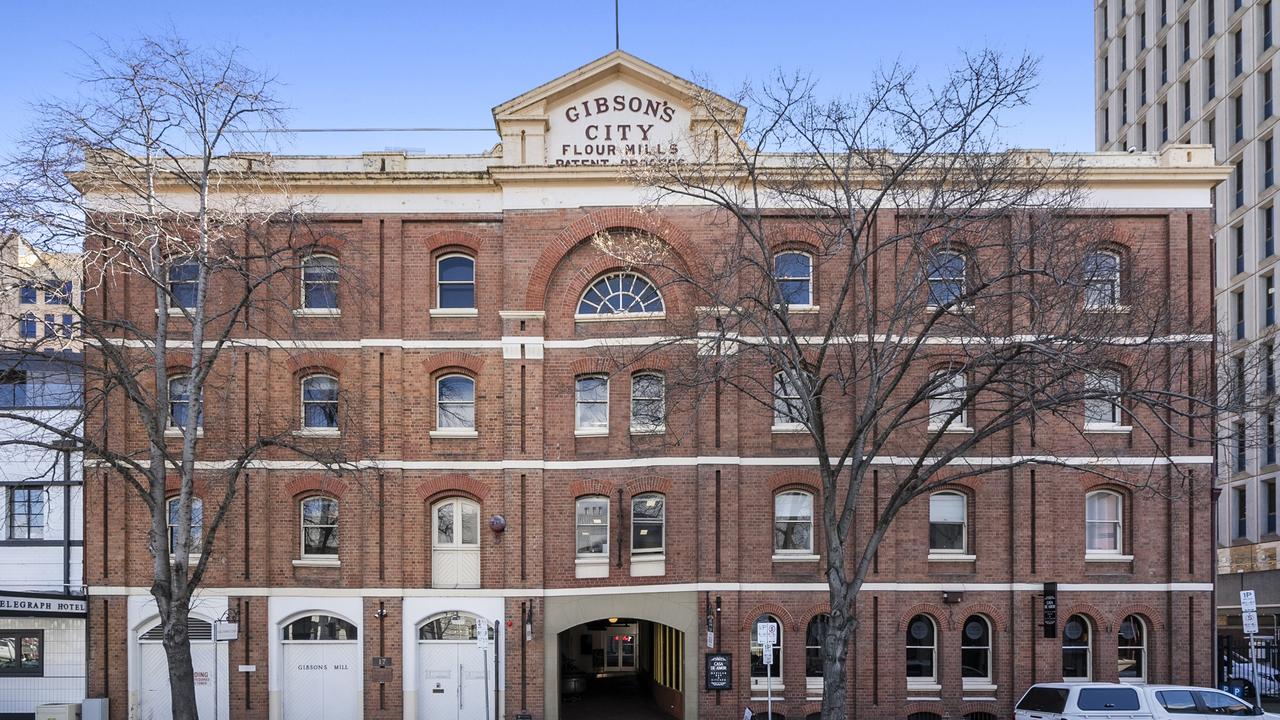Cafe Society: Architects’ vision of life on the water
A revolutionary floating hotel on the River Derwent is one step closer to becoming a reality.

Real estate
Don't miss out on the headlines from Real estate. Followed categories will be added to My News.
IT’S “three men and a baby” when I meet architect Robert Morris-Nunn and his wingmen.
The baby is not the demure trainee architect tagging along with him to our coffee date, but the venue, Hobart’s Brooke Street Pier, a floating forerunner to the project we are here to talk about.
Robert’s second waterborne baby, a ring-shaped floating hotel off the Regatta Grounds on the River Derwent, will be a world first if built.
There is no floating hotel of this type of construction or size elsewhere in the world. Such is its pioneering technology, says Robert, that it could give birth to a new specialised industry in the state — not a bad outcome for a building conceived as a “mischief” alternative to high-rise hotels in Hobart.
If it is not built, it will join other visionary projects languishing unrealised at the bottom of the sea.
“Here’s one of those,” Robert chuckles, producing an old newspaper clipping of someone else’s water design in French Polynesia.
“These designs appear in magazines in London and everywhere else, but they don’t get built,” says the architect, who pitched his unsolicited bid as part of design consortium Hunter Developments.
“The ideas seem wonderful, but unless one develops a collaborative way of bringing them into being, they don’t happen, because there are skills needed that don’t apply to normal buildings.”
MORE CAFE SOCIETY:
MEZ NEWMAN: IS THIS THE WAY TO SOLVE HOUSING CRISIS?
KATRENA STEPHENSON: COUNCILLORS’ CONFLICTING DEMANDS
PAUL BLACKLOW: IT’S TIME TO SPLASH THE CASH
CLIVE TILSLEY: KEEP IT LOCAL IS SECRET OF SUCCESS
SIMON WELLS: TAKE ADVANTAGE OF THE GOOD OIL
That’s the beauty of working on big projects in small-scale Tassie with its abundance of clever, can-do people, he says, having invited two of them along this morning — naval architect Fred Barrett and marine ecologist Sam Ibbott.
The trio first worked together developing plans for Brooke Street Pier, which was built locally and floated into Sullivans Cove in 2014.
It would not have happened without their expertise, says Robert.
And nor would the new Regatta Floating Hotel plan, which he says will be lodged in a development application to the Hobart City Council very soon, now that there is Crown consent for a seabed lease at the site.
“What we have here collectively is a lot of knowledge coming together to make it work,” he says.

The grand plan is for a 150-suite hotel over three floors. Two additional storeys would incorporate a contemporary marine science and natural history experience including an aquarium. (“You’ll be able to pat spotted handfish,” Robert jokes). There will also be a permanent home for a major River Derwent time-lapse art project.
Hotel guests could jog around the rooftop and moor small craft within the ring. For the Regatta Association, there would be new offices and a kayak repair shop along with a commitment to help reinvigorate its annual festival, the oldest of its kind in the country.
Robert says hotel guests would also support a ferry service. “That’s got to be a huge asset to the city. It should have been done decades ago. Imagine swinging into the secure marina within the ring and that’s where you alight.”
Drawings suggest a contemporary Colosseum on water or perhaps the ancient city of Carthage, says Robert, whose other projects include Saffire Resort, MACq01 and the Henry Jones Hotel.
Or maybe a salmon pen, I tease. “There’s no fish poo beneath it, to start with,” Fred shoots back. “The hotel isn’t putting nutrients into the water. It’s a benign substrate.”
Jokes aside, Sam says the marine ecology has been an integral consideration from the start. With the Derwent contaminated by legacy polluters, it’s vital for river health that additional infrastructure does not create undue sediment disturbance. So, rather than dredging and driving massive piles into the seabed for Brooke Street Pier, the team used narrow, less intrusive screw-in fixtures which they plan to reprise for the floating hotel.
“This is the happiest place in the Derwent for fishes,” Robert beams.
Scientist Sam embraces the fish-first ethos. “If it’s important to have handfish habitat, we will have them,” he says. “Our environmental recommendations are fed into designs. It is unusual to be at the front end of the project rather than coming in at the tail end as part of the approvals.
“A developer will know what they are signing on to. It’s a very different mindset: we are doing it as it ought to be done, which is by doing the right thing rather than what we can get away with.”
Is that a Tasmanian first, I ask. “It’s a world first,” laughs Fred.
The naval architect sees critical elements of the floating hotel design as revolutionary. An international patent under way corroborates that analysis. The patent is for a floating building with a double-skinned concrete pontoon, on which it floats.
In lay terms, the crucial differentiator is that this is a building that floats, not a ship that does not move.
And it is future-proof for sea level rises associated with global warming, with moorings that have a bit of give in them. In another innovation, the pontoon, structure and mooring systems are all completely removable and relocatable.
“This is transformational within the world of traditional marine infrastructure,” says Robert.


